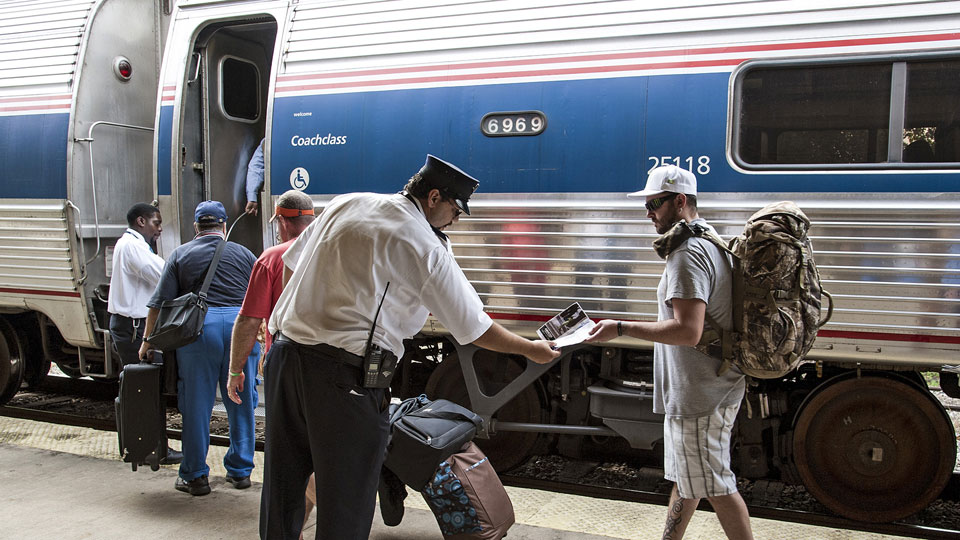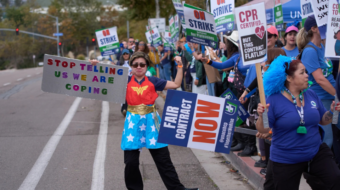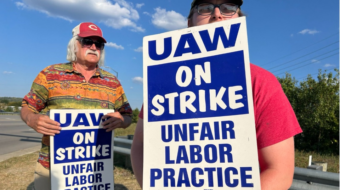
WASHINGTON—After 20 straight hours of talks between rail unions and bosses, pushed to bargaining by Democratic President Joe Biden and top administration officials, three rail unions, including the two key ones representing engineers and conductors, reached a tentative five-year agreement with freight railroad management at 4 am on September 15.
The contract, covering just over half of the nation’s 115,000 unionized rail workers, features a 24% raise over its life, bonuses, an extra unpaid sick days and better working conditions, Biden said in a five-minute midday statement from the White House Rose Garden.
The rail workers originally sought a 31% hike over five years. The railroads, who earned $146 billion in cumulative profits since the last contract was signed, before the coronavirus pandemic, offered 15% after offering little in more than two years of fruitless bargaining.
The tentative agreement covers members of the Brotherhood of Locomotive Engineers & Trainmen (BLE&T), a Teamsters Rail Conference member, the Smart-Transportation Division—the old United Transportation Union—and the Brotherhood of Railway Signalmen. It’s retroactive to July 1, 2020. There have been no general wage increases since then.
More than half of the total wage hike, 14%, will be paid up front, covering July 2020-July 2022. The workers would also get “annual lump sum” bonuses totaling $5,000. There will be a freeze on health care co-pays and deductibles, BLE&T/Teamsters President Dennis Pierce and Smart-TD President Jeremy Ferguson said in a joint statement.
Other unions which had joined those three in bargaining with the nation’s big freight railroads previously accepted recommendations from a Presidential Emergency Board on how to settle the long conflict between the carriers and their workers. That board recommended the 24% hike, but ducked all other issues.
Teamsters President Sean O’Brien and Secretary-Treasurer Fred Zuckerman, whose union includes BLE&T, and Joe Sellers, the overall president of Smart, were intensively involved in the talks, too, Pierce and Ferguson said.
Prevented nationwide rail strike
The settlement heads off the possibility the big freight railroads—including Norfolk Southern, CSX, Union Pacific and the Burlington Northern Santa Fe—would force the workers to walk starting at 12:01 am on September 16. It also heads off punitive legislation, imposing a settlement, which four Republican senators crafted and pushed.
“For the first time our unions were able to obtain negotiated contract language exempting time off for certain medical events from carrier attendance policies,’” Pierce and Ferguson continued. “Our unions will now begin the process of submitting the tentative agreement to the rank and file for a ratification vote” by union members. With no date for the balloting, one reporter asked Biden if the celebration was premature. He didn’t answer.
“Collective bargaining works. The labor movement works. And we know through lifetimes of experience and unbelievable sacrifice, Teamsters across America’s railroads work harder than anyone. Negotiations never follow a straight line but the fight for a union contract is always worth it,” said the Teamsters’ O’Brien.
The Grand Council of the Signalmen (BRS) issued a short statement: “The BRS has reached a potential tentative agreement with” the freight railroads’ coalition, “pending the approval of the general chairmen in national handling” as the union constitution mandates.
Pay and especially working conditions were the key disagreements between the unions and the railroads. The roads built schedules which forced the workers to toil for several weeks straight without a break, including through weekends and holidays, and that could force them back to work after only a day or so of rest. Calls to report to work could come at any time.
The results were erratic hours, which often didn’t let workers take time off for such things as doctors’ appointments and family funerals without giving advance notice.
And if workers were late or didn’t appear, the railroads docked “points” from their records. If a worker lost a set number of points, the railroad fired the worker.
Biden and his administration got involved because the railroads were ready to force the workers to strike at the end of a mandatory federal “cooling-off” period, a minute after midnight on September 16. The Norfolk Southern had already stopped accepting containerized freight shipments on September 11, a leaked internal memo showed.
Amtrak and commuter railroads, which use the freight lines’ tracks–except for the Northeast Corridor and the Metra lines running south from Chicago’s Loop–were already cancelling trains. The freight stoppage was designed to get shippers to pressure lawmakers to impose a settlement on the workers. The tentative agreement apparently foils that scheme.
And since you can’t run trains without engineers or conductors—though BNSF has said you can—some 30%-40% of U.S. commerce would have come literally to a dead halt had the freight railroads forced the workers to walk. Such a stoppage would have collapsed the already shaky U.S. supply chain for goods from cars to coal to wheat to, as Biden noted, “clean water.”
“This agreement is a big win for America and for both labor and management in my view,” Biden said in his press conference. The intensely and openly pro-labor president called it “a win for tens of thousands of rail workers.”
It’s also “an agreement that keeps our rail system going and our economy strong…It validated what I have always believed—that unions and management can work together.” The workers “earned and deserved those benefits” by being essential workers “who kept America moving” during the coronavirus pandemic, he declared.
A story in Common Dreams reported some flak, namely that the tentative agreement still leaves too much leeway for the railroads to jerk workers around.










